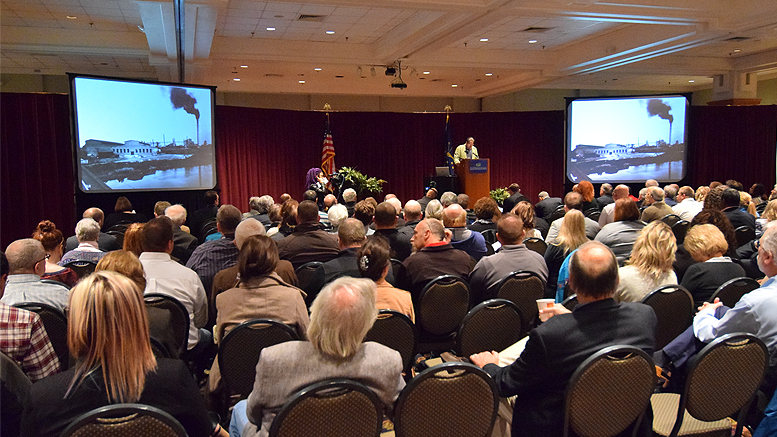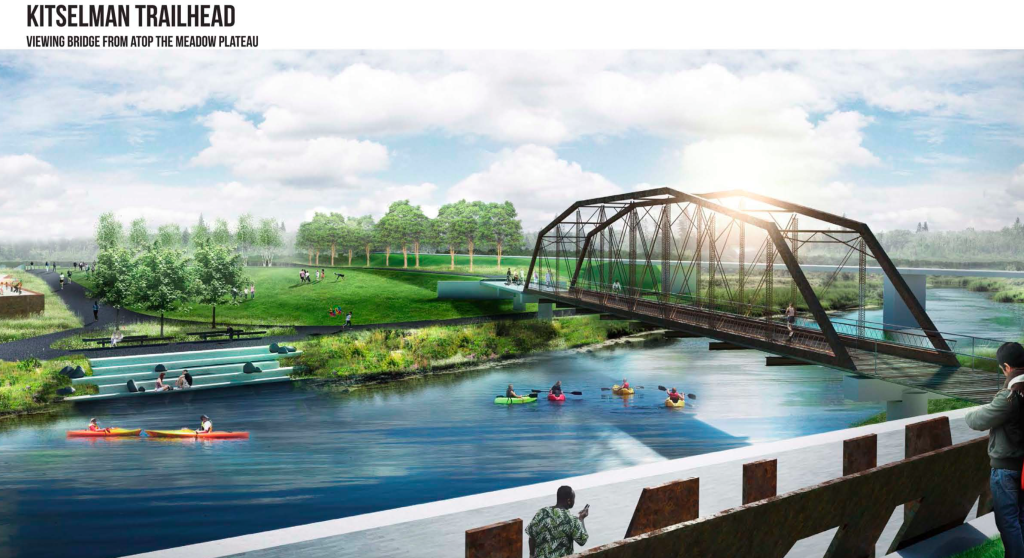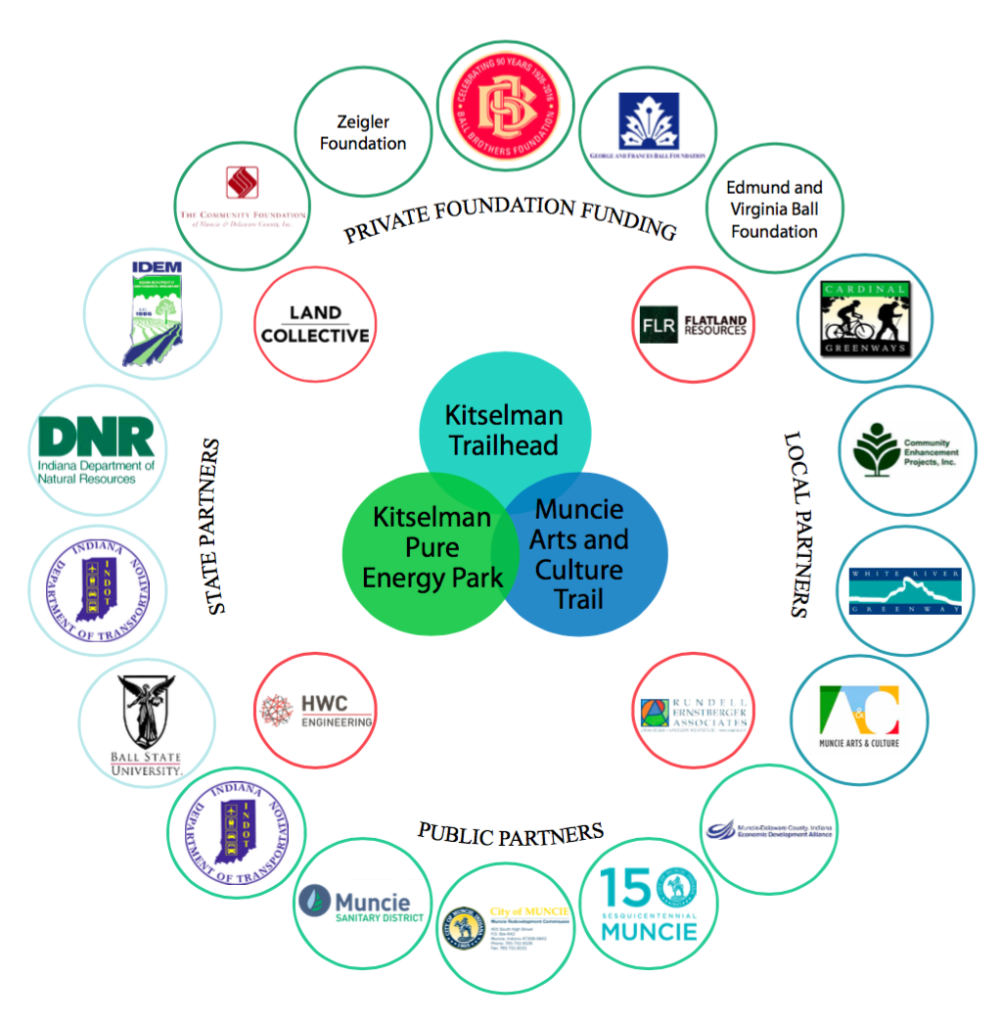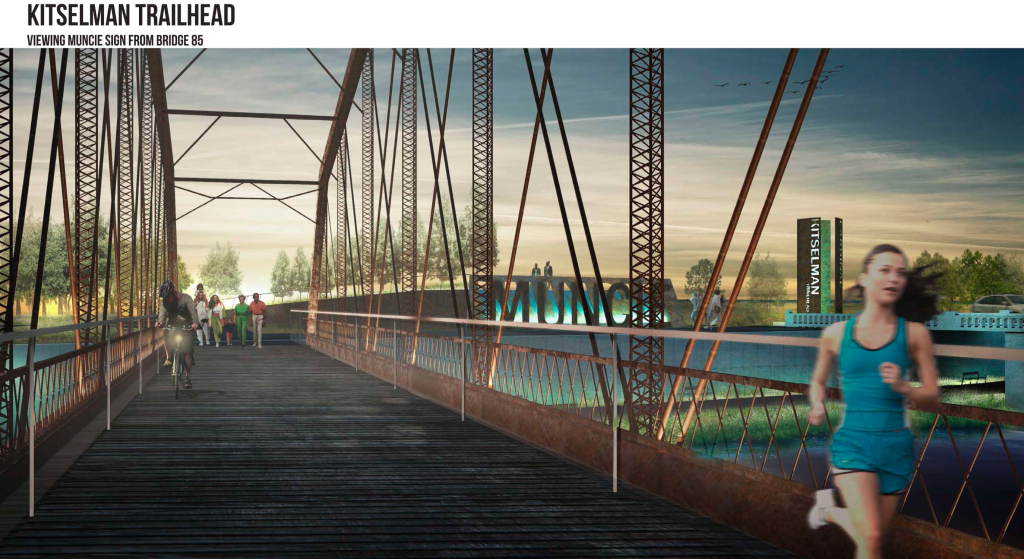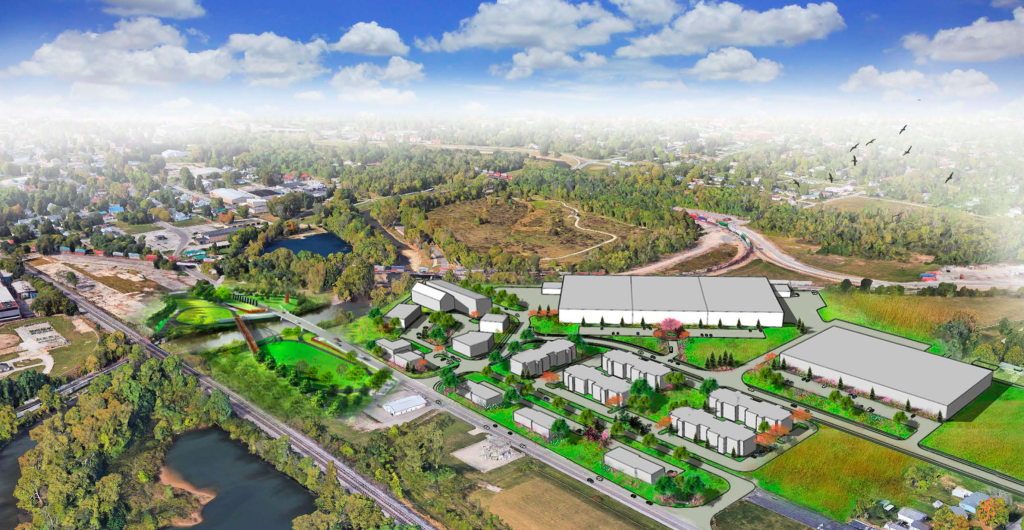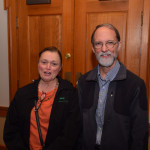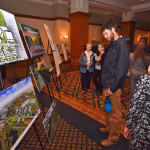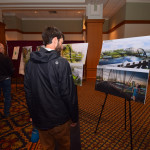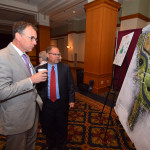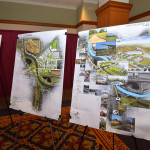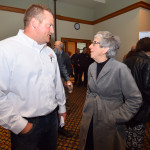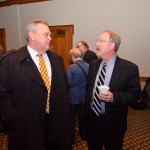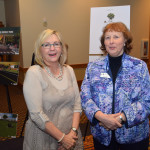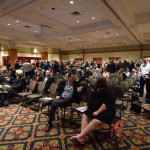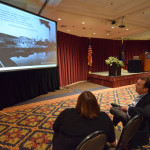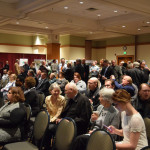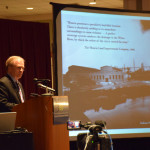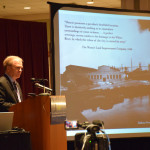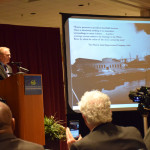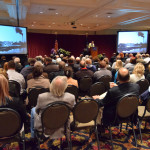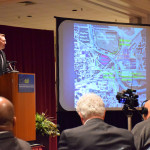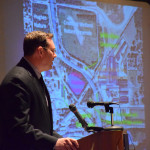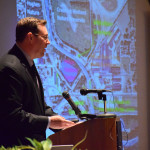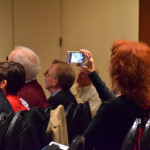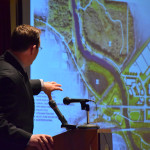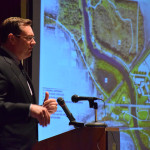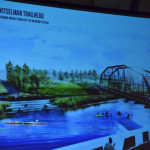Muncie, IN —At an unveiling ceremony today, Muncie Mayor Dennis Tyler announced a transformative revitalization plan for the former King Indiana Forge and Indiana Steel & Wire industrial sites, located adjacent to the White River at the city’s eastern gateway, near the 2200 block of East Jackson Street/Highway 32.
Hundreds of people attended the announcement, held at the Horizon Convention Center. After Mayor Tyler’s opening remarks, presentations were made by: Phil Tevis of FlatLand Resources; John Craddock, Director Emeritus, Bureau of Water Quality; Jud Fisher, Ball Brothers Foundation; Tom Smith, Community Enhancement Projects; Mike Cline, Muncie Sanitary District; Cecil Fenland, Rundell Ernstberger Associates; Brandye Hendrickson, INDOT; Gary Dannar, Kitsleman Pure Energy Park; David Rubin, LAND COLLECTIVE; and Todd Donati, Muncie Redevelopment Commission.
The plan, a result of decades of visionary, broad-based collaboration, was detailed by Tyler and representatives of numerous partners on the project. Significant components of the plan include the Kitselman Trailhead, a new eastern gateway to the City of Muncie, Muncie Arts & Culture Trail, and the Kitselman Pure Energy Park (KPEP).
Mayor Dennis Tyler noted, “This project is about catalyzing a revitalization of the City of Muncie, and ties into the fundamental themes of our ADVANCE ECI Regional Cities plan. The number of partners involved in today’s announcement is a testament to Muncie’s focused and collaborative approach to creating the public/private partnerships that are necessary for talent attraction, increased investment, and population growth.”The Kitselman Trailhead will occupy 18 acres on the former King Indiana Forge and Indiana Steel and Wire sites, and will link Indiana’s longest trail, the 62-mile Cardinal Greenway, with the White River Trail and the Muncie Arts & Culture Trail. The location will be the setting of a new, visually-compelling gateway for the City of Muncie in a beautiful, bold design that not only provides a significant entry in the city, but puts people at the center of this new entrance. $4.5 million in private and Indiana Department of Transportation (INDOT) financial support toward the $9 million project cost has been secured for the Kitselman Trailhead.
The impetus for today’s announcement was a local effort that began decades ago to remove contaminates from the White River. The project area has since seen significant and ongoing ecological rejuvenation after a legacy of polluting the surrounding landscape. Initial cleanup efforts have resulted in renewed interest and investment in the area and spurred completed projects such as the John M. Craddock Wetland Nature Preserve, Hughes Nature Preserve, Heron Overlook, Rotary Park, Car Doctors remediation, Highland Neighborhood Park and Phillips Pool. These projects total 59 acres that surround the new development areas.
“The Kitselman Trailhead and gateway project is an accumulation of what we hoped for 45 years ago when we started the Bureau of Water Quality, of having our community come together with many partners involved to develop, in a reasonable and responsible manner, the use and enjoyment of the White River in Muncie, Indiana,” said John M. Craddock, Director Emeritus of the Bureau of Water Quality, Muncie Sanitary District.
“Ball Brothers Foundation has been investing in this area of the city for several decades through grant funding for the John M. Craddock Wetland Nature Preserve, Cardinal Greenways, Car Doctor’s brownfield remediation, and other projects in the area. The Kitselman Trailhead is the next step in further transforming this area. The design team has done a masterful job in creating a vision for a powerful public space that will bring community members together, connect the area’s trails, and serve as a stunning gateway into the city. At the same time, the design thoughtfully interweaves aspects of the city’s rich history in a very meaningful way. We look forward to seeing this vision become a reality,” added Jud Fisher, President & COO, Ball Brothers Foundation.
A centerpiece of the redevelopment is the installation of historic Bridge 85, known as the Albany Bridge. Installed at the trailhead, it will provide a pedestrian trail crossing over the White River that will both reference days gone by, and acknowledge a bright future ahead for Muncie. The rare bridge was fabricated by the Indiana Bridge Company in 1905. The Indiana Bridge Company was founded in 1886, being one of Muncie’s longest and continuous businesses. The retired Albany Bridge is one of the few camelback truss bridges standing in the State of Indiana. Relocation of the historic bridge was required to make way for a new bridge in Albany that could handle heavier vehicles.
“Relocation of the Albany Bridge 85 was critical to the success of the new bridge being installed in Albany by the Delaware County Commissioners. Cardinal Greenway was very fortunate and proud to be able to find a new home for the retired Albany Bridge. Its new location over the White River in Muncie at the Kitselman Trailhead is sure to be award-winning and will enhance the experience for our thousands of trail users and provide an amazing gateway into the City of Muncie. The newly-named Kitselman Bridge ties in nicely with our vision as we are ‘One Trail…Actively Connecting Our Communities,” said Angie Pool, CEO Cardinal Greenway, Inc.
In addition to the inclusion of historic Bridge 85, the Kitselman Trailhead features two banks that are pushed and pulled to create several dynamic spaces unified in one multimodal landscape. Citizens will be able to see their City from new perspectives and vantage points, whether on foot, on bicycle, on kayak, or from a vehicle passing by on their way to work. While the design includes a range of spaces that allow for timeless occupation by citizens and visitors, the design works to utilize the materials of the local industries – ball glass, weathered steel, and concrete – to reference the rich manufacturing history of the site.
David Rubin, Principal of Philadelphia-based LAND COLLECTIVE lead the collaborative effort, alongside HWC Engineering and Flatland Resources, to design this new landscape for Muncie. “The pulling of the western bank allows the design to encompass a new sign for the City’s entry along Highway 32 and will stand as a key element of this new gateway. The letters for Muncie peel away from the Corten steel retaining wall to be visible to all those entering the City from the east. Behind the letters retained in the earth are shards of Ball glass which, when illuminated at night, will glow the classic blue, backlighting the name Muncie for all to see.”
The Kitselman Trailhead, with its joining of the Cardinal and White River Greenways, becomes a vital spine of the Muncie Arts & Culture Trail (MACC Trail), a linear park, which will connect key city amenities and attractions. The MACC Trail will link vibrant city sectors: BSU, Village, IU Health Ball Memorial Hospital, DWNTWN, Minnetrista, Delaware County Fairgrounds, Muncie Central High School, many city parks, and all the residential neighborhoods in between.
“The potential benefits of the MACC Trail are great and precedents have shown the long-term benefits far outweigh the initial investment. Executed correctly, this facility will provide a sustainable, recreational, and commuting amenity that will link all of the City’s arts, cultural, neighborhood, and educational destinations, while also serving as a catalyst for mixed-use development and community revitalization,” commented Cecil Penland, Principal, Rundell Ernstberger Associates.
A pilot project demonstrating the future landscape fabric of the MACC Trail was recently completed by the Muncie Sanitary District (MSD) as a part of the Franklin Street and downtown sewer separation project. Labeled Liberty Pass, the trail and canal are excellent examples of how infrastructure projects that typically only occur every 75 to 100 years, and are rarely seen after installation, can become the catalyst of urban renewal. The Muncie Sanitary District has been focused on the area around the Kitselman Project site for many years. Sewer separation and levee upgrades from High Street, upstream to just beyond Indiana Steel & Wire, are a high priority location for the MSD.
“The Muncie Sanitary District has a responsibility to the Muncie citizens to remove pollutants from the White River and protect city residents from flooding landward of the river levees. The Kitselman Trailhead fits within this charge. MSD is separating sewers along the White River near the former Indiana Steel and Wire Site in the Highland Park and the old East End neighborhoods. At the same time, MSD is in the process of upgrading levees in and around the Kitselman Trailhead area. The Muncie Sanitary District is pleased to be a collaborative partner by marrying the federal clean water and levee mandates with Muncie quality of life improvements. The Sanitary District is committed to the implementation of sustainable infrastructure in and around the Kitselman Project,” noted Mike Cline, Muncie Sanitary District Board of Commissioners.
A new, privately-owned business park, Kitselman Pure Energy Park (KPEP), will be located adjacent to the Trailhead along the north side of Highway 32. Formerly the home to Indiana Steel & Wire, the property was once designated as a Superfund site by the Environmental Protection Agency (EPA). After decades of environmental clean-up, the property has been reclassified as a brownfield and declared suitable by Indiana Department of Environmental Management (IDEM) for light manufacturing, commercial, and possible other uses. Clean up will continue at the former Indiana Steel & Wire site into the future with a concentrated focus on cleaning the contaminated groundwater that is deep underground. The ongoing remediation efforts of the groundwater requires continued monitoring and reporting to the Muncie Bureau of Water Quality and IDEM to assure the use of best practices and continued public safety.
One key requirement of IDEM, in order to repurpose the former Indiana Steel and Wire property for KPEP’s development, is the mass fill of the site of up to 6 feet of clay to cap the remaining footers of the wire mill. This cap serves a dual purpose by raising the KPEP site above the 100 year flood elevation, thereby reducing the need for the Bunch Boulevard flood control levee. Because the levee walls and road berm will no longer be required, Bunch Boulevard will be relocated over parts of the old wire mill site. Relocation of Bunch Boulevard will make way for the White River Greenway to connect the Craddock Wetland to the relocated and newly-named Kitselman Bridge.
The Bunch Boulevard relocation will create a new gateway into the KPEP and entrance for the Kitselman Trailhead parking lot, making it safer for automobiles traveling along Highway 32. INDOT is eager to eliminate the blind corner at the Bunch Boulevard – East Jackson Street Bridge signal.
“With continued cooperation of the Greenways, City of Muncie, INDOT and IDEM, Kitselman Pure Energy Park gives Muncie a Live/Work development, in a place that focuses on river and trail recreation. All of which is next door to a vibrant and growing downtown community,” said Gary Dannar, KPEP Indiana, LLC.
KPEP has commitments of more than $25 million in private investment, which includes a manufacturing facility and other amenities. Pending the approval of the Muncie City Council on April 4, KPEP will partner with the City of Muncie to relocate Bunch Boulevard to serve the business park and the Kitselman Trailhead. Total estimated road infrastructure is estimated to cost $3.5 million. Additionally, INDOT will invest $1.92 million to replace the Jackson Street/Highway 32 Bridge, which runs through the project area. Construction of the entire area will begin the spring of 2016 and is expected to continue through the next five years.
“It has been said that each generation will form its own relationship with the river. The generation of 2016 embraces the White River as the city’s greatest natural resource. It is the longest, most giving, and continuous economic engine of the city. Whether it was for a Native American fishing to feed his family, for the first grist mill, industrial dams for cooling, levees for flood protection, or the use of the river as an open sewer, the White River and its big bend at Minnetrista has always been integral to Muncie. Legacy projects of this importance to the City of Muncie’s future occur, at best, once in a century. Many community leaders have worked, in some cases, for multiple generations, to turn the White River into Muncie’s great escape and our best kept secret. Our river is open to all. It’s free for all ages, races, religions and socioeconomic classes. The unveiling of the Kitselman Trailhead is a proud day for the City of Muncie and Muncie’s ability to work with broad-based partnerships to improve our quality of place. We are setting a great example of how to celebrate the river for the next 100 hundred years and beyond,” stated Mayor Dennis Tyler.
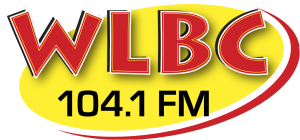 Listen to the entire presentation as recorded by WLBC. (It’s 2 hours in three parts.)
Listen to the entire presentation as recorded by WLBC. (It’s 2 hours in three parts.)
Part One.
Part Two.
Part Three.
Photos from the announcement today. Click on a thumbnail to see larger images and to run a clickable slide show.
- Jud Fisher, President & COO, Ball Brothers Foundation is pictured. Photo by: Mike Rhodes

